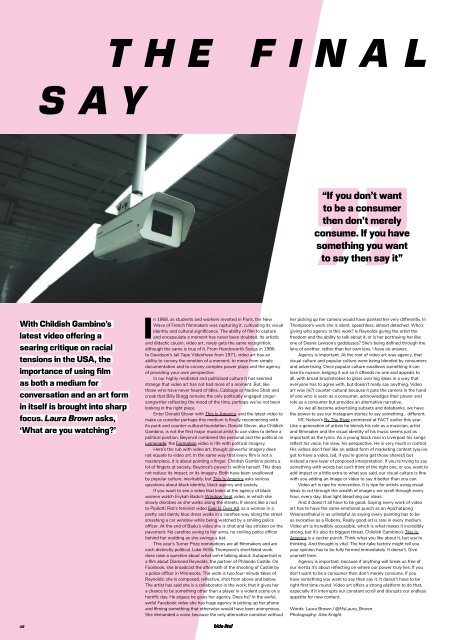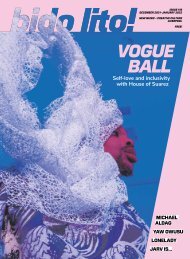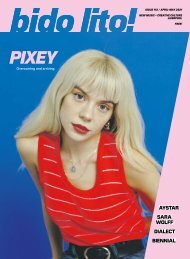Issue 89 / June 2018
June 2018 issue of Bido Lito! magazine. Featuring: ART OF FOOTBALL, BEACH SKULLS, BONNACONS OF DOOM, LAAF and POSITIVE VIBRATION, ALEX CAMERON, TRACKY, SOUND CITY 2018 REVIEW and much more.
June 2018 issue of Bido Lito! magazine. Featuring: ART OF FOOTBALL, BEACH SKULLS, BONNACONS OF DOOM, LAAF and POSITIVE VIBRATION, ALEX CAMERON, TRACKY, SOUND CITY 2018 REVIEW and much more.
Create successful ePaper yourself
Turn your PDF publications into a flip-book with our unique Google optimized e-Paper software.
SAY<br />
THE FINAL<br />
“If you don’t want<br />
to be a consumer<br />
then don’t merely<br />
consume. If you have<br />
something you want<br />
to say then say it”<br />
With Childish Gambino’s<br />
latest video offering a<br />
searing critique on racial<br />
tensions in the USA, the<br />
importance of using film<br />
as both a medium for<br />
conversation and an art form<br />
in itself is brought into sharp<br />
focus. Laura Brown asks,<br />
‘What are you watching?’<br />
In 1968, as students and workers revolted in Paris, the New<br />
Wave of French filmmakers was capturing it, cultivating its visual<br />
identity and cultural significance. The ability of film to capture<br />
and encapsulate a moment has never been doubted. Its artistic<br />
and didactic cousin, video art, rarely gets the same recognition,<br />
although the same is true of it. From Handsworth Songs in 1986<br />
to Davidson’s Jail Tape Videofreex from 1971, video art has an<br />
ability to convey the emotion of a moment, to move from simple<br />
documentation and to convey complex power plays and the agency<br />
of providing your own perspective.<br />
In our highly mediated and politicised culture it has seemed<br />
strange that video art has not had more of a moment. But, like<br />
those who have never heard of Idles, Cabbage or Nadine Shah and<br />
croak that Billy Bragg remains the only politically engaged singersongwriter<br />
reflecting the mood of the time, perhaps we’ve not been<br />
looking in the right place.<br />
Enter Donald Glover with This Is America, and the latest video to<br />
make us consider perhaps this medium is finally reconnecting with<br />
its punk and counter-cultural foundation. Donald Glover, aka Childish<br />
Gambino, is not the first major musical artist to use video to define a<br />
political position. Beyoncé combined the personal and the political on<br />
Lemonade; the Formation video is rife with political imagery.<br />
Here’s the rub with video art, though: powerful imagery does<br />
not equate to video art. In the same way that every film is not a<br />
masterpiece, it is about pointing a finger. Childish Gambino points a<br />
lot of fingers at society, Beyoncé’s power is within herself. This does<br />
not reduce its impact, or its imagery. Both have been swallowed<br />
by popular culture, inevitably, but This Is America asks serious<br />
questions about black identity, black agency and society.<br />
If you want to see a video that looks at the agency of black<br />
women watch Erykah Badu’s Window Seat video, in which she<br />
slowly disrobes as she walks along the streets. It seems like a nod<br />
to Pipilotti Rist’s feminist video Ever Is Over All, as a woman in a<br />
pretty and dainty blue dress walks in a carefree way along the street<br />
smashing a car window while being watched by a smiling police<br />
officer. At the end of Badu’s video she is shot and lies stricken on the<br />
pavement. No carefree swing to her arms, no smiling police officer<br />
behind her nodding as she swings a bat.<br />
This year’s Turner Prize nominations are all filmmakers and are<br />
each distinctly political. Luke Willis Thompson’s shortlisted work<br />
does raise a question about what we’re talking about. Autoportrait is<br />
a film about Diamond Reynolds, the partner of Philando Castile. On<br />
Facebook, she broadcast the aftermath of the shooting of Castile by<br />
a police officer in Minnesota. The work is two four-minute takes of<br />
Reynolds; she is composed, reflective, shot from above and below.<br />
The artist has said she is a collaborator in the work; that it gives her<br />
a chance to be something other than a player in a violent scene on a<br />
horrific day. He argues he gives her agency. Does he? In the awful,<br />
awful Facebook video she has huge agency in picking up her phone<br />
and filming something that otherwise would have been anonymous.<br />
She demanded a voice, because the only alternative narrative without<br />
her picking up her camera would have painted her very differently. In<br />
Thompson’s work she is silent, speechless, almost detached. Who’s<br />
giving who agency in this work? Is Reynolds giving the artist the<br />
freedom and the ability to talk about it, or is her portraying her like<br />
one of Deana Lawson’s goddesses? She’s being defined through the<br />
lens of another, rather than her own lens. I have no answer.<br />
Agency is important. At the root of video art was agency, that<br />
visual culture and popular culture were being blended by consumers<br />
and advertising. Once popular culture swallows something it can<br />
lose its nuance, beiging it out so it offends no one and appeals to<br />
all, with broad brushstrokes to gloss over big ideas in a way that<br />
everyone has to agree with, but doesn’t really say anything. Video<br />
art was (is?) counter-cultural because it puts the camera in the hand<br />
of one who is seen as a consumer, acknowledges their power and<br />
role as a consumer but provides an alternative narrative.<br />
As we all become advertising subsets and databanks, we have<br />
the power to use our Instagram stories to say something… different.<br />
MC Nelson’s By The River premiered at FACT earlier this year.<br />
Like a generation of artists he blends his role as a musician, artist<br />
and filmmaker and the visual identity of his music seems just as<br />
important as the lyrics. As a young black man in Liverpool his songs<br />
reflect his voice, his view, his perspective. He is very much in control.<br />
His videos don’t feel like an added form of marketing content (you’ve<br />
got to have a video, lad, if you’re gonna get those shares!) but<br />
instead a new layer of proposed interpretation. If you’re trying to say<br />
something with words but can’t think of the right one, or you want to<br />
add impact or a little extra to what you said, our visual culture is fine<br />
with you adding an image or video to say it better than you can.<br />
Video art is ripe for reinvention. It is ripe for artists using visual<br />
ideas to cut through the wealth of imagery we scroll through every<br />
hour, every day, blue light bleaching our ideas.<br />
And it doesn’t all have to be good. Saying every work of video<br />
art has to have the same emotional punch as an Apichatpong<br />
Weerasethakul is as unhelpful as saying every painting has to be<br />
as evocative as a Rubens. Really good art is rare in every medium.<br />
Video art is incredibly accessible, which is what makes it incredibly<br />
strong, but it’s also its biggest threat. Childish Gambino’s This Is<br />
America is a sucker punch. Think what you like about it, but you’re<br />
thinking. And thought is vital. The hot-take factory might tell you<br />
your opinion has to be fully formed immediately. It doesn’t. Give<br />
yourself time.<br />
Agency is important, because if anything will break us free of<br />
our inertia it’s about reflecting on where our power truly lies. If you<br />
don’t want to be a consumer then don’t merely consume. If you<br />
have something you want to say then say it. It doesn’t have to be<br />
right first time round. Video art offers a strong platform to do that,<br />
especially if it interrupts our constant scroll and disrupts our endless<br />
appetite for new content.<br />
Words: Laura Brown / @MsLaura_Brown<br />
Photography: Alex Knight<br />
46


















